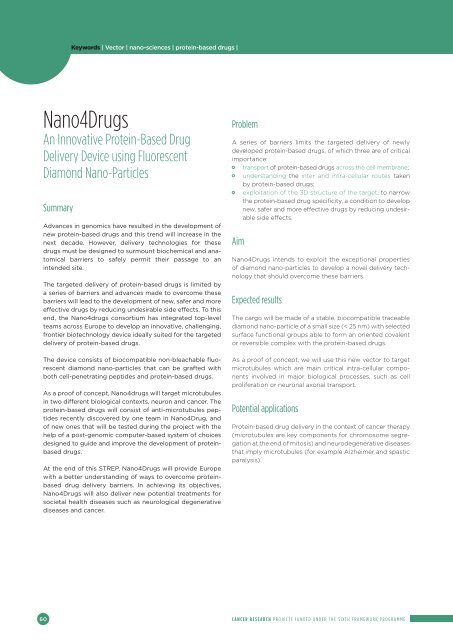You also want an ePaper? Increase the reach of your titles
YUMPU automatically turns print PDFs into web optimized ePapers that Google loves.
Nano4Drugs<br />
An Innovative Protein-Based Drug<br />
Delivery Device using Fluorescent<br />
Diamond Nano-Particles<br />
Summary<br />
Advances in genomics have resulted in the development of<br />
new protein-based drugs and this trend will increase in the<br />
next decade. However, delivery technologies for these<br />
drugs must be designed to surmount biochemical and anatomical<br />
barriers to safely permit their passage to an<br />
intended site.<br />
The targeted delivery of protein-based drugs is limited by<br />
a series of barriers and advances made to overcome these<br />
barriers will lead to the development of new, safer and more<br />
eff ective drugs by reducing undesirable side eff ects. To this<br />
end, the Nano4drugs consortium has integrated top-level<br />
teams across Europe to develop an innovative, challenging,<br />
frontier biotechnology device ideally suited for the targeted<br />
delivery of protein-based drugs.<br />
The device consists of biocompatible non-bleachable fl uorescent<br />
diamond nano-particles that can be grafted with<br />
both cell-penetrating peptides and protein-based drugs.<br />
As a proof of concept, Nano4drugs will target microtubules<br />
in two diff erent biological contexts, neuron and cancer. The<br />
protein-based drugs will consist of anti-microtubules peptides<br />
recently discovered by one team in Nano4Drug, and<br />
of new ones that will be tested during the project with the<br />
help of a post-genomic computer-based system of choices<br />
designed to guide and improve the development of proteinbased<br />
drugs.<br />
At the end of this STREP, Nano4Drugs will provide Europe<br />
with a better understanding of ways to overcome proteinbased<br />
drug delivery barriers. In achieving its objectives,<br />
Nano4Drugs will also deliver new potential treatments for<br />
societal health diseases such as neurological degenerative<br />
diseases and cancer.<br />
60<br />
Keywords | Vector | nano-sciences | protein-based drugs |<br />
Problem<br />
A series of barriers limits the targeted delivery of newly<br />
developed protein-based drugs, of which three are of critical<br />
importance:<br />
• transport of protein-based drugs across the cell membrane;<br />
• understanding the inter and intra-cellular routes taken<br />
by protein-based drugs;<br />
• exploitation of the 3D structure of the target, to narrow<br />
the protein-based drug specifi city, a condition to develop<br />
new, safer and more eff ective drugs by reducing undesirable<br />
side eff ects.<br />
Aim<br />
Nano4Drugs intends to exploit the exceptional properties<br />
of diamond nano-particles to develop a novel delivery technology<br />
that should overcome these barriers.<br />
Expected results<br />
The cargo will be made of a stable, biocompatible traceable<br />
diamond nano-particle of a small size (< 25 nm) with selected<br />
surface functional groups able to form an oriented covalent<br />
or reversible complex with the protein-based drugs.<br />
As a proof of concept, we will use this new vector to target<br />
microtubules which are main critical intra-cellular components<br />
involved in major biological processes, such as cell<br />
proliferation or neuronal axonal transport.<br />
Potential applications<br />
Protein-based drug delivery in the context of cancer therapy<br />
(microtubules are key components for chromosome segregation<br />
at the end of mitosis) and neurodegenerative diseases<br />
that imply microtubules (for example Alzheimer and spastic<br />
paralysis).<br />
CANCER RESEARCH PROJECTS FUNDED UNDER THE SIXTH FRAMEWORK PROGRAMME
















